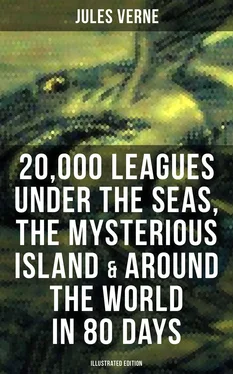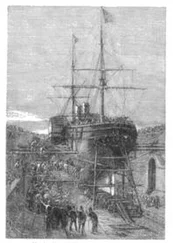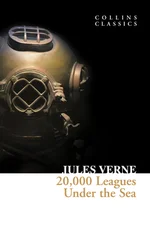“Would master kindly come here for an instant?” he said to me in an odd voice.
“What is it, Conseil?”
“It’s something that master should see.”
I stood up, went, leaned on my elbows before the window, and I saw it.
In the broad electric daylight, an enormous black mass, quite motionless, hung suspended in the midst of the waters. I observed it carefully, trying to find out the nature of this gigantic cetacean. Then a sudden thought crossed my mind.
“A ship!” I exclaimed.
“Yes,” the Canadian replied, “a disabled craft that’s sinking straight down!”
Ned Land was not mistaken. We were in the presence of a ship whose severed shrouds still hung from their clasps. Its hull looked in good condition, and it must have gone under only a few hours before. The stumps of three masts, chopped off two feet above the deck, indicated a flooding ship that had been forced to sacrifice its masting. But it had heeled sideways, filling completely, and it was listing to port even yet. A sorry sight, this carcass lost under the waves, but sorrier still was the sight on its deck, where, lashed with ropes to prevent their being washed overboard, some human corpses still lay! I counted four of them—four men, one still standing at the helm— then a woman, halfway out of a skylight on the afterdeck, holding a child in her arms. This woman was young. Under the brilliant lighting of the Nautilus’s rays, I could make out her features, which the water hadn’t yet decomposed. With a supreme effort, she had lifted her child above her head, and the poor little creature’s arms were still twined around its mother’s neck! The postures of the four seamen seemed ghastly to me, twisted from convulsive movements, as if making a last effort to break loose from the ropes that bound them to their ship. And the helmsman, standing alone, calmer, his face smooth and serious, his grizzled hair plastered to his brow, his hands clutching the wheel, seemed even yet to be guiding his wrecked three-master through the ocean depths!
What a scene! We stood dumbstruck, hearts pounding, before this shipwreck caught in the act, as if it had been photographed in its final moments, so to speak! And already I could see enormous sharks moving in, eyes ablaze, drawn by the lure of human flesh!
Meanwhile, turning, the Nautilus made a circle around the sinking ship, and for an instant I could read the board on its stern:
The Florida
Sunderland, England
Table of Contents
THIS DREADFUL SIGHT was the first of a whole series of maritime catastrophes that the Nautilus would encounter on its run. When it plied more heavily traveled seas, we often saw wrecked hulls rotting in midwater, and farther down, cannons, shells, anchors, chains, and a thousand other iron objects rusting away.
Meanwhile, continuously swept along by the Nautilus, where we lived in near isolation, we raised the Tuamotu Islands on December 11, that old “dangerous group” associated with the French global navigator Commander Bougainville; it stretches from Ducie Island to Lazareff Island over an area of 500 leagues from the east-southeast to the west-northwest, between latitude 13 degrees 30’ and 23 degrees 50’ south, and between longitude 125 degrees 30’ and 151 degrees 30’ west. This island group covers a surface area of 370 square leagues, and it’s made up of some sixty subgroups, among which we noted the Gambier group, which is a French protectorate. These islands are coral formations. Thanks to the work of polyps, a slow but steady upheaval will someday connect these islands to each other. Later on, this new island will be fused to its neighboring island groups, and a fifth continent will stretch from New Zealand and New Caledonia as far as the Marquesas Islands.
The day I expounded this theory to Captain Nemo, he answered me coldly:
“The earth doesn’t need new continents, but new men!”
Sailors’ luck led the Nautilus straight to Reao Island, one of the most unusual in this group, which was discovered in 1822 by Captain Bell aboard the Minerva. So I was able to study the madreporic process that has created the islands in this ocean.
Madrepores, which one must guard against confusing with precious coral, clothe their tissue in a limestone crust, and their variations in structure have led my famous mentor Professor Milne-Edwards to classify them into five divisions. The tiny microscopic animals that secrete this polypary live by the billions in the depths of their cells. Their limestone deposits build up into rocks, reefs, islets, islands. In some places, they form atolls, a circular ring surrounding a lagoon or small inner lake that gaps place in contact with the sea. Elsewhere, they take the shape of barrier reefs, such as those that exist along the coasts of New Caledonia and several of the Tuamotu Islands. In still other localities, such as Réunion Island and the island of Mauritius, they build fringing reefs, high, straight walls next to which the ocean’s depth is considerable.
While cruising along only a few cable lengths from the underpinning of Reao Island, I marveled at the gigantic piece of work accomplished by these microscopic laborers. These walls were the express achievements of madrepores known by the names fire coral, finger coral, star coral, and stony coral. These polyps grow exclusively in the agitated strata at the surface of the sea, and so it’s in the upper reaches that they begin these substructures, which sink little by little together with the secreted rubble binding them. This, at least, is the theory of Mr. Charles Darwin, who thus explains the formation of atolls—a theory superior, in my view, to the one that says these madreporic edifices sit on the summits of mountains or volcanoes submerged a few feet below sea level.
I could observe these strange walls quite closely: our sounding lines indicated that they dropped perpendicularly for more than 300 meters, and our electric beams made the bright limestone positively sparkle.
In reply to a question Conseil asked me about the growth rate of these colossal barriers, I thoroughly amazed him by saying that scientists put it at an eighth of an inch per biennium.
“Therefore,” he said to me, “to build these walls, it took … ?”
“192,000 years, my gallant Conseil, which significantly extends the biblical Days of Creation. What’s more, the formation of coal— in other words, the petrification of forests swallowed by floods— and the cooling of basaltic rocks likewise call for a much longer period of time. I might add that those ‘days’ in the Bible must represent whole epochs and not literally the lapse of time between two sunrises, because according to the Bible itself, the sun doesn’t date from the first day of Creation.”
When the Nautilus returned to the surface of the ocean, I could take in Reao Island over its whole flat, wooded expanse. Obviously its madreporic rocks had been made fertile by tornadoes and thunderstorms. One day, carried off by a hurricane from neighboring shores, some seed fell onto these limestone beds, mixing with decomposed particles of fish and marine plants to form vegetable humus. Propelled by the waves, a coconut arrived on this new coast. Its germ took root. Its tree grew tall, catching steam off the water. A brook was born. Little by little, vegetation spread. Tiny animals—worms, insects—rode ashore on tree trunks snatched from islands to windward. Turtles came to lay their eggs. Birds nested in the young trees. In this way animal life developed, and drawn by the greenery and fertile soil, man appeared. And that’s how these islands were formed, the immense achievement of microscopic animals.
Near evening Reao Island melted into the distance, and the Nautilus noticeably changed course. After touching the Tropic of Capricorn at longitude 135 degrees, it headed west-northwest, going back up the whole intertropical zone. Although the summer sun lavished its rays on us, we never suffered from the heat, because thirty or forty meters underwater, the temperature didn’t go over 10 degrees to 12 degrees centigrade.
Читать дальше












